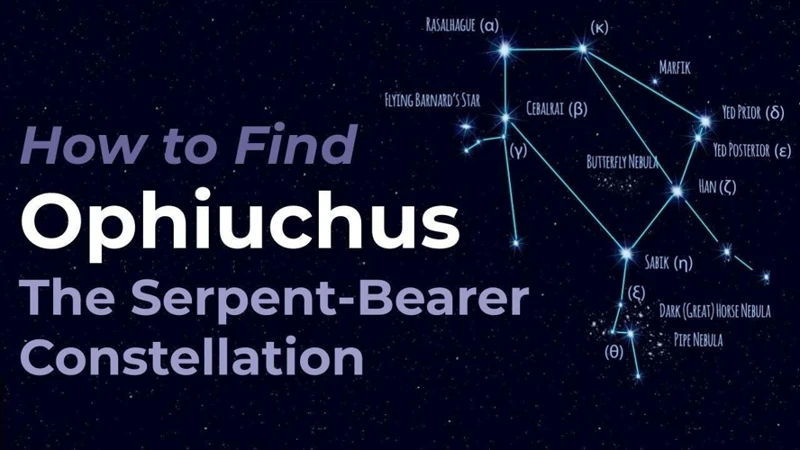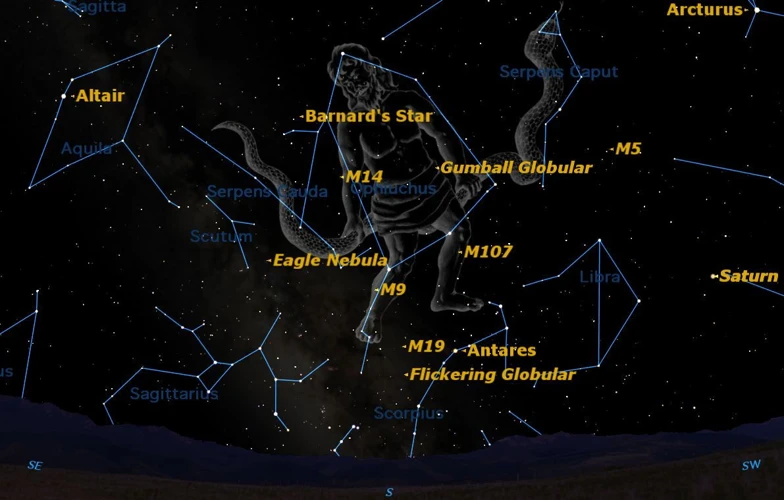Have you ever looked up into the night sky and wondered about the mysterious constellations that adorn it? One such constellation that often goes unnoticed is Ophiuchus. Although not officially recognized as a zodiac sign, Ophiuchus holds a significant place in both astronomy and astrology. In this article, we will delve into the fascinating world of Ophiuchus, providing tips on how to spot this elusive constellation, its historical origins, notable features, and even its role in astrology. So, grab your binoculars and get ready to unravel the secrets of Ophiuchus in the vast expanse of the night sky.
Contents
- About Ophiuchus
- Locating Ophiuchus
- Notable Features
- Ophiuchus in Astrology
- Conclusion
-
Frequently Asked Questions
- 1. Can Ophiuchus be considered as a zodiac sign?
- 2. What is the mythological origin of Ophiuchus?
- 3. How can I locate Ophiuchus in the night sky?
- 4. What is the best time and season to observe Ophiuchus?
- 5. Do I need any special tools to spot Ophiuchus?
- 6. Which are the brightest stars in Ophiuchus?
- 7. Are there any fascinating deep-sky objects in Ophiuchus?
- 8. How does Ophiuchus influence astrology?
- 9. Is there a specific birthstone or color associated with Ophiuchus?
- 10. Can Ophiuchus have an impact on my career choices?
- References
-
Frequently Asked Questions
- Is Ophiuchus a recognized zodiac constellation?
- What is the Ophiuchus zodiac sign known for?
- How did Ophiuchus originate in mythology?
- Where can Ophiuchus be spotted in the night sky?
- Any tips for spotting Ophiuchus in the night sky?
- When is the best time to observe Ophiuchus?
- What tools can aid in spotting Ophiuchus?
- Which are the brightest stars in Ophiuchus?
- Are there any notable deep-sky objects associated with Ophiuchus?
- How is Ophiuchus connected to astrology?
- References
- Read More
About Ophiuchus

Ophiuchus, often referred to as the “Serpent Bearer,” is a remarkable constellation that lies near the celestial equator. While it may not be officially recognized as a zodiac sign, this mystical constellation holds ancient symbolism and significance. With its roots in both astronomy and astrology, Ophiuchus is said to bridge the divide between the zodiac signs of Scorpio and Sagittarius. The Ophiuchus constellation is home to several fascinating stars and deep-sky objects, including the prominent Rasalhague and Barnard’s Star. With its enigmatic nature and intriguing associations, Ophiuchus continues to captivate stargazers and astrology enthusiasts alike. To delve deeper into the unique characteristics of Ophiuchus, its mythology, and its potential influence on career choices, visit this link.
The Ophiuchus Zodiac Sign
The Ophiuchus Zodiac Sign, although not officially recognized in Western astrology, has its roots in ancient Babylonian and Greek astrology. Ophiuchus is represented by a figure holding a snake, symbolizing the power to heal and regenerate. People born between November 29th and December 17th are said to be born under the influence of this mysterious sign. Known for their wisdom, knowledge, and desire for spiritual enlightenment, Ophiuchus individuals possess remarkable healing abilities and a deep understanding of the human psyche. Their natural inclination towards exploration and transformation makes them excellent problem solvers and guides. While some astrologers argue that Ophiuchus should be included in the zodiac, others believe it represents a unique and rare energy that is not easily placed within traditional astrological frameworks. To explore more about the fascinating mythology behind the Olympian gods and goddesses, click here.
Mythology and Origin
In the realm of mythology and origin, Ophiuchus has a rich and captivating backstory. In Greek mythology, the constellation represents the healer Asclepius, son of Apollo and Coronis. Asclepius was known for his exceptional medical skills and became a renowned physician. Legend has it that he possessed the power to raise the dead, which alarmed the gods of Olympus. To maintain the balance between life and death, Zeus struck down Asclepius with a thunderbolt. In honor of his extraordinary abilities, Asclepius was immortalized in the night sky as the constellation Ophiuchus.
The origin of Ophiuchus predates Greek mythology, with roots in ancient Babylonian and Egyptian civilizations. In Babylonian astrology, Ophiuchus was associated with the god Enki, who was revered as a god of wisdom, magic, and healing. In Egyptian mythology, the constellation is linked to Imhotep, the legendary physician and architect of the Step Pyramid of Djoser.
The inclusion of Ophiuchus in astrology is a relatively recent development. Its placement along the ecliptic and its proximity to Scorpio and Sagittarius led some astrologers to assign Ophiuchus as the thirteenth zodiac sign. This sparked debates and discussions among astrology enthusiasts, with some embracing the addition of Ophiuchus while others disregarded its significance.
To explore the potential influence of Ophiuchus on zodiac signs and career choices, you can read more at this link. The mythology and origin of Ophiuchus adds an intriguing layer to its cosmic presence, making it a constellation that continues to fascinate astronomers and astrologers alike.
Locating Ophiuchus

Locating Ophiuchus in the night sky can be a thrilling challenge for avid stargazers. To spot this elusive constellation, there are a few useful tips to keep in mind. First, it is helpful to familiarize oneself with the neighboring constellations of Scorpius and Sagittarius, as Ophiuchus intertwines with them. One can start by identifying some key stars in these nearby constellations as reference points. Additionally, Ophiuchus can be found by tracing a line from the bright star Antares in Scorpius, up towards the constellation Hercules. It is important to note that Ophiuchus is a rather large constellation that spans across a wide area of the sky, so patience and perseverance are key. With the aid of star maps, astronomy apps, or even a good ol’ star chart, the quest to locate Ophiuchus becomes an exciting celestial treasure hunt.
Tips for Observing
When it comes to observing Ophiuchus in the night sky, there are several tips that can enhance your stargazing experience. Follow these suggestions to make the most out of your observation:
1. Find a Dark Location: Ophiuchus is best observed from a location away from light pollution. Choose a spot where the night sky is clear and free from bright city lights, allowing for better visibility of the constellation.
2. Use a Star Chart or Mobile App: A star chart or mobile app can be immensely helpful in identifying and locating Ophiuchus in the vast expanse of stars. These tools provide a guided map of the night sky, making it easier to navigate and pinpoint constellations.
3. Look for Ophiuchus’ Key Features: Ophiuchus is characterized by its distinctive shape, resembling a person holding a serpent. Look for the bright star, Rasalhague, which marks the head of the serpent. Once you locate Rasalhague, trace the constellation’s body and locate other stars and objects within it.
4. Patiently Await Ideal Conditions: The best time to observe Ophiuchus is during a moonless night when the sky is darkest, allowing for better visibility of fainter stars and deep-sky objects within the constellation.
5. Bring Binoculars or a Telescope: While Ophiuchus’ key stars are visible to the naked eye, binoculars or a telescope can enhance your viewing experience. They allow for a closer look at the constellation’s stars and even some of the associated deep-sky objects.
By following these tips for observing Ophiuchus, you can increase the chances of spotting and appreciating this elusive constellation in all its celestial splendor.
Best Time and Season
Determining the best time and season to spot the Ophiuchus constellation can greatly enhance your chances of observing it in all its splendor. While Ophiuchus can be seen throughout the year, there are certain periods when it is more visible and easier to locate.
1. Summer Months: One of the best times to spot Ophiuchus is during the summer months of June, July, and August. During this time, the constellation reaches its highest point in the sky, making it more prominent and easily identifiable.
2. Late Evening: Ophiuchus rises in the eastern sky during the late evening hours, making it visible during the latter part of the night. For optimal visibility, it is recommended to wait until a few hours after sunset to ensure that the constellation has risen above the horizon.
3. Dark Skies: To fully appreciate the Ophiuchus constellation, it is essential to choose a location away from light pollution. Light pollution can hinder your ability to observe the faint stars and intricate details of the constellation. Find a secluded spot away from city lights or consider visiting an astronomy observatory where the night sky is often clearer.
By timing your observations during the summer months, waiting until late evening, and seeking out dark skies, you can increase your chances of spotting the elusive Ophiuchus constellation. Remember to bring along a star chart or a mobile astronomy app to assist you in identifying the constellation among the myriad of stars in the night sky. Happy stargazing!
Tools for Spotting
When it comes to spotting the elusive Ophiuchus constellation, having the right tools can greatly enhance your stargazing experience. Here are some essential tools to aid you in your quest:
1. Telescope: A telescope is an invaluable tool for observing celestial objects in detail. With its ability to zoom in and reveal intricate features, a telescope allows you to explore the stars and deep-sky objects within Ophiuchus with great clarity. Look for a telescope with a decent aperture size to gather more light and improve visibility.
2. Binoculars: If you’re looking for a more portable and budget-friendly option, a pair of binoculars can be a fantastic tool for spotting Ophiuchus. Binoculars provide a wider field of view compared to telescopes, making it easier to take in the entire constellation. Opt for binoculars with a higher magnification power and a wide field of view for the best results.
3. Star charts and apps: To navigate the night sky and locate Ophiuchus accurately, rely on star charts or mobile apps specifically designed for stargazing. These resources provide detailed maps of the night sky, including the position of constellations, stars, and other astronomical objects. Some apps even offer real-time tracking and augmented reality features, enhancing your stargazing experience.
4. Red flashlight: When observing the night sky, it’s important to preserve your night vision. A red flashlight is essential as it doesn’t interfere with your eyes’ adaptation to darkness. This tool allows you to read star charts and make adjustments to your telescope or binoculars without sacrificing your ability to see the faint details of Ophiuchus and the surrounding celestial objects.
5. Sky atlas: A sky atlas is a comprehensive guide to the night sky, providing detailed information about constellations, stars, and deep-sky objects. Consider investing in a good-quality sky atlas that includes Ophiuchus and its associated features. These atlases often provide additional information and interesting facts that can enrich your stargazing experience.
By equipping yourself with these tools, you’ll be well-prepared to embark on an exciting journey to spot the elusive Ophiuchus constellation. Whether you opt for a telescope, binoculars, or rely on star charts and apps, these tools will enhance your ability to observe and appreciate the wonders of the night sky.
Notable Features

One of the intriguing aspects of the Ophiuchus constellation is its assortment of notable features. Among these features are the brightest stars that adorn the constellation’s celestial canvas. One such star is Rasalhague, a dazzling binary star system located at the head of Ophiuchus. Known for its luminosity, Rasalhague shines brightly in the night sky, making it a prominent landmark for stargazers. Another notable star in Ophiuchus is Barnard’s Star, which holds the distinction of being the fourth-closest known individual star to our solar system. Apart from these stars, Ophiuchus is also home to several deep-sky objects, including globular clusters, nebulae, and galaxies. These cosmic wonders provide astronomers with a wealth of fascinating subjects to explore and study. So, keep your eyes peeled for the awe-inspiring sights that await you when observing the notable features of Ophiuchus.
Brightest Stars in Ophiuchus
When it comes to the brightest stars in the Ophiuchus constellation, there are a few notable ones that stand out. Here are some of the brightest stars that adorn the celestial landscape of Ophiuchus:
1. Rasalhague (Alpha Ophiuchi): Rasalhague is the brightest star in Ophiuchus and one of the most stunning sights in the night sky. Located approximately 49 light-years away from Earth, this blue-white giant shines with a luminosity over 100 times that of our Sun. Its name comes from the Arabic phrase for “the head of the serpent bearer.”
2. Cebalrai (Beta Ophiuchi): Cebalrai, also known as Kelb Alrai, is the second brightest star in Ophiuchus. It is a yellow giant star situated about 84 light-years away from Earth. Cebalrai is relatively smaller and cooler than Rasalhague but still adds to the constellation’s overall brilliance.
3. Sabik (Eta Ophiuchi): Sabik is a binary star system composed of two bluish-white stars. It is located approximately 88 light-years away from us and contributes to the luminosity of Ophiuchus. Its name originates from Arabic and means “preceding” or “forerunner,” as it appears to precede other stars in the constellation.
4. Barnard’s Star (V2500 Ophiuchi): While not one of the brightest stars in the night sky, Barnard’s Star is notable for its proximity to us. It is one of the closest known stars, situated only about 6 light-years away. This red dwarf star, with its relatively low luminosity, can be challenging to spot without binoculars or a telescope.
These brightest stars add sparkle to the Ophiuchus constellation, enhancing its allure and beckoning stargazers to explore its secrets in the vast expanse of the night sky.
Associated Deep-Sky Objects
Associated Deep-Sky Objects have always been a subject of fascination for astronomers and stargazers when exploring the vast expanse of Ophiuchus. One notable deep-sky object within the constellation is the Ophiuchus Cluster, also known as Abell 1656. This massive galaxy cluster is located approximately 320 million light-years away from Earth and contains over 1,000 member galaxies. Another intriguing deep-sky object in Ophiuchus is the Barnard’s Star, a red dwarf that is one of the closest stars to our solar system. It is known for its relatively high proper motion and proximity, making it a popular subject for scientific research. Additionally, Ophiuchus is home to the Eagle Nebula, a stunning emission nebula that is famous for its iconic “Pillars of Creation.” These towering structures of interstellar gas and dust serve as stellar nurseries, giving birth to new stars. The association of these deep-sky objects with Ophiuchus adds to the allure and allure of this constellation, making it a must-observe target for astronomers and stargazers seeking wonders beyond our own galaxy.
Ophiuchus in Astrology

Ophiuchus, despite being excluded from the traditional zodiac, has gained attention and speculation in the realm of astrology. Some astrologers have proposed including Ophiuchus as the 13th zodiac sign, shifting the dates of the existing signs. This notion stems from the idea that Ophiuchus represents a personality archetype that is distinct and profound. Those born under Ophiuchus are described as intelligent, driven, and seekers of knowledge. They possess healing abilities and are often associated with medical professions or alternative healing practices. Ophiuchus individuals are believed to have a transformative influence on those around them and possess a strong desire for spiritual growth. However, it is important to note that not all astrologers recognize Ophiuchus as a zodiac sign, and its inclusion in astrology remains a subject of debate and interpretation. Whether you choose to incorporate Ophiuchus into your astrological readings or not, exploring its symbolism can provide a deeper understanding of the diverse tapestry of the celestial world.
Conclusion

In conclusion, Ophiuchus may be an elusive constellation in the night sky, but its allure and significance cannot be overlooked. Whether you are an astronomy enthusiast or someone with an interest in astrology, Ophiuchus offers a unique experience to explore. From its historical origins and mythological connections to its notable features and deep-sky objects, Ophiuchus reveals a rich tapestry of celestial wonders. While it may not be officially recognized as a zodiac sign, its presence and symbolism continue to intrigue and spark curiosity. So, next time you find yourself gazing up at the stars, don’t forget to search for the enigmatic Ophiuchus, the serpent bearer. Its celestial beauty and fascinating stories are waiting to be discovered.
Frequently Asked Questions

1. Can Ophiuchus be considered as a zodiac sign?
Ophiuchus is not officially recognized as a zodiac sign in Western astrology. However, in sidereal astrology, which is practiced in some Eastern cultures, Ophiuchus is indeed considered a zodiac sign.
2. What is the mythological origin of Ophiuchus?
The constellation of Ophiuchus has its roots in Greek mythology. Ophiuchus is associated with Asclepius, the ancient Greek god of medicine and healing. According to myth, Asclepius possessed the power to heal the sick and even resurrect the dead.
3. How can I locate Ophiuchus in the night sky?
Ophiuchus can be found close to the constellation Scorpius in the southern sky during the summer months in the Northern Hemisphere. Look for a pattern resembling a man holding a snake, with the snake represented by the nearby constellation Serpens.
4. What is the best time and season to observe Ophiuchus?
Ophiuchus is most visible during the summer months in the Northern Hemisphere, particularly in the months of July and August. During this time, Ophiuchus can be seen high in the southern sky during the late evening hours.
5. Do I need any special tools to spot Ophiuchus?
While Ophiuchus can be seen with the naked eye, using binoculars or a telescope can enhance your viewing experience. The use of these tools allows you to observe the constellation’s intricate features and explore the various stars and deep-sky objects within Ophiuchus.
6. Which are the brightest stars in Ophiuchus?
The brightest star in Ophiuchus is Rasalhague, a bluish-white main-sequence star located near the head of the serpent. Other notable stars include Sabik, Yed Prior, and Yed Posterior, which form the “body” of the constellation.
7. Are there any fascinating deep-sky objects in Ophiuchus?
Yes, Ophiuchus is home to several interesting deep-sky objects. One notable object is the Ophiuchus Cluster, a sprawling group of galaxies located near the center of the constellation. Another impressive deep-sky object is the Barnard’s Star, a nearby red dwarf star with the largest proper motion of any known star.
8. How does Ophiuchus influence astrology?
While not recognized in Western astrology, some astrologers believe that Ophiuchus can have an influence on individuals born between November 30th and December 17th. These individuals are said to possess traits associated with Ophiuchus, such as healing abilities and a desire for knowledge.
9. Is there a specific birthstone or color associated with Ophiuchus?
Ophiuchus does not have a specific birthstone or color associated with it. However, individuals who feel a connection to Ophiuchus may choose to incorporate stones or colors that resonate with the constellation’s symbolic meanings, such as healing crystals or shades of deep green or purple.
10. Can Ophiuchus have an impact on my career choices?
In astrology, Ophiuchus is often associated with traits such as wisdom, intuition, and the pursuit of knowledge. Some believe that individuals with strong Ophiuchus influences in their birth chart may be drawn to careers in healing professions, research, teaching, or other fields that require deep understanding and intuition.
References
Frequently Asked Questions

Is Ophiuchus a recognized zodiac constellation?
Yes, Ophiuchus is a recognized zodiac constellation. It may not be included in the traditional twelve zodiac signs, but it is acknowledged as a thirteenth constellation by astronomers.
What is the Ophiuchus zodiac sign known for?
Ophiuchus is associated with traits such as wisdom, healing, intuition, and a deep understanding of the mysteries of life. People born under this sign are believed to be seekers of knowledge and possess great spiritual insight.
How did Ophiuchus originate in mythology?
In Greek mythology, Ophiuchus is associated with the legendary healer, Asclepius. He was known for his ability to revive the dead and was immortalized as a constellation to honor his miraculous healing powers.
Where can Ophiuchus be spotted in the night sky?
Ophiuchus can be spotted in the southern sky, positioned between the constellations of Scorpius and Sagittarius. It lies along the celestial equator, making it visible from both the northern and southern hemispheres.
Any tips for spotting Ophiuchus in the night sky?
To spot Ophiuchus, look for a distinct “S” or snake-like shape formed by its brightest stars. It can be helpful to use a star chart or a mobile app that provides real-time sky maps to locate the constellation accurately.
When is the best time to observe Ophiuchus?
The best time to observe Ophiuchus is during the summer months in the northern hemisphere and the winter months in the southern hemisphere. These seasons offer clear, dark skies for optimal stargazing.
What tools can aid in spotting Ophiuchus?
Binoculars or a telescope can enhance the viewing experience when observing Ophiuchus. They can help bring out the finer details of the constellation and make it easier to identify its individual stars.
Which are the brightest stars in Ophiuchus?
Ophiuchus contains several bright stars, including Rasalhague, Sabik, and Cebalrai. These stars add to the allure and beauty of the constellation when observed in the night sky.
Are there any notable deep-sky objects associated with Ophiuchus?
Yes, Ophiuchus is home to several notable deep-sky objects. The most famous one is the Barnard’s Star, a red dwarf known for its high proper motion. Additionally, there are various star clusters and nebulae that can be observed within the constellation.
How is Ophiuchus connected to astrology?
Ophiuchus has gained attention within astrology due to its position along the ecliptic, the path followed by the Sun, Moon, and planets. Some astrologers suggest that this constellation should be considered as a thirteenth zodiac sign, leading to debates and discussions among astrology enthusiasts.
References
- Help! I Can’t See Detail On The Planets! | by phpdevster
- How to Find Ophiuchus the Serpent-Bearer Constellation







